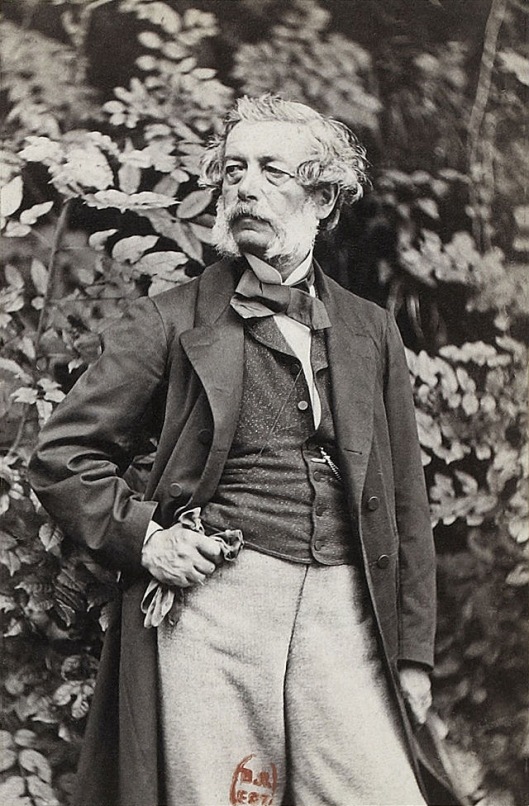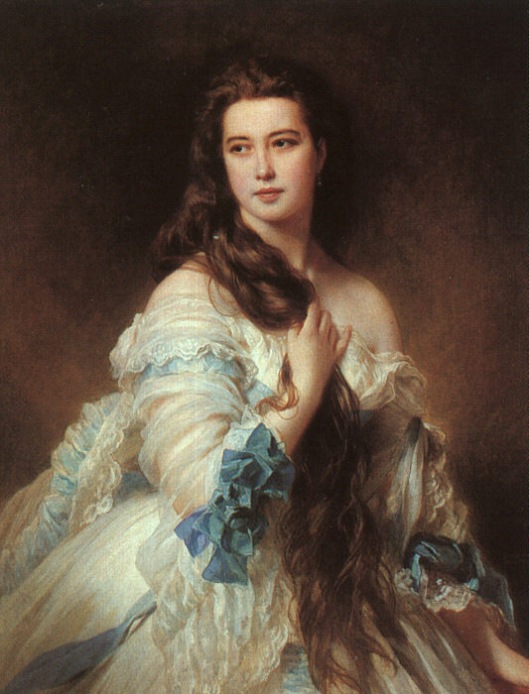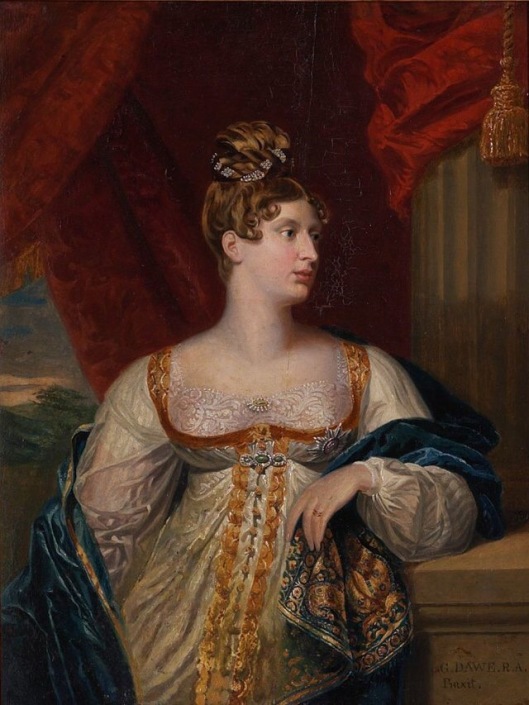Princess Charlotte Augusta of Wales (January 7, 1796 – November 6, 1817) was the only child of King George IV of the United Kingdom of Great Britain and Ireland, King of Hanover, who was still Prince of Wales (and also the Prince Regent) during her lifetime, and Caroline of Brunswick. If she had outlived both her grandfather King George III and her father, she would have become Queen of the United Kingdom, but she died following childbirth at the age of 21.
Charlotte’s parents disliked each other from before their arranged marriage and soon separated. The Prince of Wales left most of Charlotte’s care to governesses and servants, but only allowed her limited contact with Caroline, who eventually left the country. George IV, at the time the Prince Regent, had been raised under strict conditions, which he had rebelled against. Despite this, he attempted to put his daughter, who had the appearance of a grown woman at age 15, under even stricter conditions. He gave her a clothing allowance insufficient for an adult princess, and insisted that if she attended the opera, she was to sit in the rear of the box and leave before the end.

Princess Charlotte of Wales
With the Prince Regent busy with affairs of state, Charlotte was required to spend most of her time at Windsor with her maiden aunts. Bored, she soon became infatuated with her first cousin, George FitzClarence, illegitimate son of Prince William, Duke of Clarence (future King William IV). FitzClarence was, shortly thereafter, called to Brighton to join his regiment, and Charlotte’s gaze fell on Lieutenant Charles Hesse of the Light Dragoons, reputedly the illegitimate son of Charlotte’s uncle, Prince Frederick, Duke of York and Albany. Hesse and Charlotte had a number of clandestine meetings.
Lady de Clifford feared the Prince Regent’s rage should they be found out, but Princess Caroline was delighted by her daughter’s passion. She did everything that she could to encourage the relationship, even allowing them time alone in a room in her apartments. These meetings ended when Hesse left to join the British forces in Spain. Most of the Royal Family, except the Prince Regent, were aware of these meetings, but did nothing to interfere, disapproving of the way George was treating his daughter.
In 1813, with the tide of the Napoleonic Wars having turned firmly in Britain’s favour, George began to seriously consider the question of Charlotte’s marriage. The Prince Regent and his advisors decided on Willem Hereditary Prince of Orange, son and heir-apparent of Prince Willem VI of Orange (later Kings Willem I and King Willem II of the Netherlands respectively). Such a marriage would increase British influence in Northwest Europe. Prince Willem made a poor impression on Charlotte when she first saw him, at George’s birthday party on August 12, when he became intoxicated, as did the Prince Regent himself and many of the guests. Although no one in authority had spoken to Charlotte about the proposed marriage, she was quite familiar with the plan through palace whispers. Dr. Henry Halford was detailed to sound out Charlotte about the match; he found her reluctant, feeling that a future British queen should not marry a foreigner.
Believing that his daughter intended to marry her cousin Prince William Frederick, Duke of Gloucester and Edinburgh, the Prince Regent saw his daughter and verbally abused both her and Gloucester. According to Charlotte, “He spoke as if he had the most improper ideas of my inclinations. I see that he is compleatly [sic] poisoned against me, and that he will never come round.” She wrote to Earl Grey for advice; he suggested she play for time. The matter soon leaked to the papers, which wondered whether Charlotte would marry “the Orange or the Cheese” (a reference to Gloucester cheese), “Slender Billy” [of Orange] or “Silly Billy”.
The Prince Regent attempted a gentler approach, but failed to convince Charlotte who wrote that “I could not quit this country, as Queen of England still less” and that if they wed, the Prince of Orange would have to “visit his frogs solo”. However, on December 12, the Prince Regent arranged a meeting between Charlotte and the Prince of Orange at a dinner party, and asked Charlotte for her decision. She stated that she liked what she had seen so far, which George took as an acceptance, and quickly called in the Prince of Orange to inform him.
Negotiations over the marriage contract took several months, with Charlotte insisting that she not be required to leave Britain. The diplomats had no desire to see the two thrones united, and so the agreement stated that Britain would go to the couple’s oldest son, while the second son would inherit the Netherlands; if there was only one son, the Netherlands would pass to the German branch of the House of Orange.
On June 10, 1814, Charlotte signed the marriage contract. Charlotte had become besotted with a Prussian prince whose identity is uncertain; according to Charles Greville, it was Prince August, although historian Arthur Aspinall disagreed, thinking that her love interest was the younger Prince Friedrich. At a party at the Pulteney Hotel in London, Charlotte met a Lieutenant-General in the Russian cavalry, Prince Leopold of Saxe-Coburg-Saalfeld.

Prince Leopold of Saxe-Coburg-Saalfeld
Prince Leopold was born in Coburg in the tiny German duchy of Saxe-Coburg-Saalfeld in modern-day Bavaria on December 16, 1790. He was the youngest son of Franz , Duke of Saxe-Coburg-Saalfeld, and Countess Augusta Reuss-Ebersdorf. In 1826, Saxe-Coburg acquired the city of Gotha from the neighboring Duchy of Saxe-Gotha-Altenburg (after the death of its last Duke, Friedrich IV of Saxe-Gotha-Altenburg) and gave up Saalfeld to Saxe-Meiningen, becoming Saxe-Coburg-Gotha.
The Princess invited Leopold to call on her, an invitation he took up, remaining for three quarters of an hour, and writing a letter to the Prince Regent apologising for any indiscretion. This letter impressed George very much, although he did not consider the impoverished Leopold as a possible suitor for his daughter’s hand.
The Princess of Wales opposed the match between her daughter and the Prince of Orange, and had great public support: when Charlotte went out in public, crowds would urge her not to abandon her mother by marrying the Prince of Orange. Charlotte informed the Prince of Orange that if they wed, her mother would have to be welcome in their home—a condition sure to be unacceptable to the Prince Regent. When the Prince of Orange would not agree, Charlotte broke off the engagement.
Her father’s response was to order that Charlotte remain at her residence at Warwick House (adjacent to Carlton House) until she could be conveyed to Cranbourne Lodge at Windsor, where she would be allowed to see no one except the Queen. When told of this, Charlotte raced out into the street. A man, seeing her distress from a window, helped the inexperienced Princess find a hackney cab, in which she was conveyed to her mother’s house. Caroline was visiting friends and hastened back to her house, while Charlotte summoned Whig politicians to advise her. A number of family members also gathered, including her uncle, the Duke of York—with a warrant in his pocket to secure her return by force if need be. After lengthy arguments, the Whigs advised her to return to her father’s house, which she did the next day.

Charlotte’s personal coat of arms, 1816
The story of Charlotte’s flight and return was soon the talk of the town; Henry Brougham, a former MP and future Whig Lord Chancellor, reported “All are against the Prince”, and the Opposition press made much of the tale of the runaway Princess. Despite an emotional reconciliation with his daughter, the Prince Regent soon had her conveyed to Cranbourne Lodge, where her attendants were under orders never to let her out of their sight. She was able to smuggle a note out to her favourite uncle, Prince Augustus, Duke of Sussex. The Duke responded by questioning the Tory Prime Minister, Lord Liverpool, in the House of Lords. He asked whether Charlotte was free to come and go, whether she was allowed to go to the seaside as doctors had recommended for her in the past, and now that she was eighteen, whether the government planned to give her a separate establishment. Liverpool evaded the questions, and the Duke was summoned to Carlton House and castigated by the Prince Regent, who never spoke with his brother again.
Despite her isolation, Charlotte found life at Cranbourne Lodge surprisingly agreeable, and slowly became reconciled to her situation. At the end of July 1814, the Prince Regent visited Charlotte in her isolation and informed her that her mother was about to leave England for an extended stay on the Continent. This upset Charlotte, but she did not feel that anything she might say could change her mother’s mind, and was further aggrieved by her mother’s casualness in the leavetaking, “for God knows how long, or what events may occur before we meet again”. Charlotte would never see her mother again.
In late August, Charlotte was permitted to go to the seaside. She had asked to go to fashionable Brighton, but the Prince Regent refused, sending her instead to Weymouth. As the Princess’s coach stopped along the way, large, friendly crowds gathered to see her; according to Holme, “her affectionate welcome shows that already people thought of her as their future Queen”. On arrival in Weymouth, there were illuminations with a centrepiece “Hail Princess Charlotte, Europe’s Hope and Britain’s Glory”. Charlotte spent time exploring nearby attractions, shopping for smuggled French silks, and from late September taking a course of heated seawater baths. She was still infatuated with her Prussian, and hoped in vain that he would declare his interest in her to the Prince Regent. If he did not do so, she wrote to a friend, she would “take the next best thing, which was a good tempered man with good sence [sic] … that man is the P of S-C” [Prince of Saxe-Coburg, i.e. Leopold].
In mid-December, shortly before leaving Weymouth, she “had a very sudden and great shock” when she received news that her Prussian had formed another attachment. In a long talk after Christmas dinner, father and daughter made up their differences.
In the early months of 1815, Charlotte fixed on Leopold (or as she termed him, “the Leo”) as a spouse. Her father refused to give up hope that Charlotte would agree to marry the Prince of Orange. However, Charlotte wrote, “No arguments, no threats, shall ever bend me to marry this detested Dutchman.”
Faced with the united opposition of the Royal Family, George finally gave in and dropped the idea of marriage to the Prince of Orange, who became engaged to Grand Duchess Anna Pavlovna of Russia that summer. Charlotte contacted Leopold through intermediaries, and found him receptive, but with Napoleon renewing the conflict on the Continent, Leopold was with his regiment fighting. In July, shortly before returning to Weymouth, Charlotte formally requested her father’s permission to marry Leopold. The Prince Regent replied that with the unsettled political situation on the Continent, he could not consider such a request. To Charlotte’s frustration, Leopold did not come to Britain after the restoration of peace, even though he was stationed in Paris, which she deemed to be only a short journey from Weymouth or London.
In January 1816, the Prince Regent invited his daughter to the Royal Pavilion in Brighton, and she pleaded with him to allow the marriage. On her return to Windsor, she wrote her father, “I no longer hesitate in declaring my partiality in favour of the Prince of Coburg—assuring you that no one will be more steady or consistent in this their present & last engagement than myself.” George gave in and summoned Leopold, who was in Berlin en route to Russia, to Britain. Leopold arrived in Britain in late February 1816, and went to Brighton to be interviewed by the Prince Regent.
After Charlotte was invited as well, and had dinner with Leopold and her father, she wrote:
I find him charming, and go to bed happier than I have ever done yet in my life … I am certainly a very fortunate creature, & have to bless God. A Princess never, I believe, set out in life (or married) with such prospects of happiness, real domestic ones like other people.
The Prince Regent was impressed by Leopold, and told his daughter that Leopold “had every qualification to make a woman happy”. Charlotte was sent back to Cranbourne on March 2, leaving Leopold with the Prince Regent. On 14 March, an announcement was made in the House of Commons to great acclaim, with both parties relieved to have the drama of the Princess’s romances at an end.
Parliament voted Leopold £50,000 per year, purchased Claremont House for the couple, and allowed them a generous single payment to set up house. Fearful of a repetition of the Orange fiasco, George limited Charlotte’s contact with Leopold; when Charlotte returned to Brighton, he allowed them to meet only at dinner, and never let them be alone together.

1818 engraving of the wedding of Charlotte and Leopold
The marriage ceremony was set for May 2, 1816. On the wedding day, huge crowds filled London; the wedding participants had great difficulties in travelling. At nine o’clock in the evening in the Crimson Drawing Room at Carlton House, with Leopold dressing for the first time as a British General (the Prince Regent wore the uniform of a Field Marshal), the couple were married. Charlotte’s wedding dress cost over ₤10,000. The only mishap was during the ceremony, when Charlotte was heard to giggle when the impoverished Leopold promised to endow her with all his worldly goods.
The couple honeymooned at Oatlands Palace, the Duke of York’s residence in Surrey. Neither was well and the house was filled with the Yorks’ dogs and the odour of animals. Nevertheless, the Princess wrote that Leopold was “the perfection of a lover”. Two days after the marriage, they were visited by the Prince Regent at Oatlands; he spent two hours describing the details of military uniforms to Leopold, which according to Charlotte “is a great mark of the most perfect good humour”. Prince Leopold and his wife returned to London for the social season, and when they attended the theatre, they were invariably treated to wild applause from the audience and the singing of “God Save the King” from the company. When she was taken ill at the Opera, there was great public concern about her condition. It was announced that she had suffered a miscarriage. On August 24, 1816, they took up residence for the first time at Claremont.
After a year and a half of happy marriage, Charlotte died after delivering a stillborn son. Charlotte’s death set off tremendous mourning among the British, who had seen her as a sign of hope and a contrast both to her unpopular father and to her grandfather, whom they deemed mad. As she had been King George III’s only legitimate grandchild, there was considerable pressure on the King’s unmarried sons to find wives. King George III’s fourth son, Prince Edward, Duke of Kent and Strathearn, fathered the eventual heir, Victoria, who was born 18 months after Charlotte’s death.
In 1831 Prince Leopold was elected the first King of the Belgians following the country’s independence in 1830. He reigned between July 1831 and December 1865. His descendant still sits on the throne of Belgium.





























